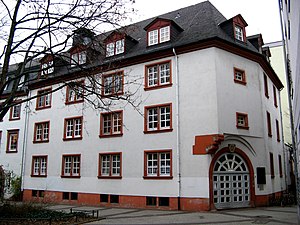Algesheimer Hof
The Algesheimer Hof , also known as the Hof zum Algesheimer , is a historicizing new building from the 1970s. It is located at Hinteren Christofsgasse 3 in the old town of Mainz .
location
The Algesheimer Hof is located in the old town of Mainz, on the corner of Christophsgässchen and Hintere Christophsgasse, on the edge of Karmeliterplatz . In terms of urban planning, it now forms one end of an axis that runs from the presumed birthplace of Gutenberg, the Hof zum Gutenberg via the Church of St. Christoph , the baptismal church of Gutenberg, to the retirement home and presumed death house of Gutenberg in the Algesheimer Hof.
history
In 1463, after the conquest of the city of Mainz, the court was lent to Ludwig von Lichtenberg as a castle loan by Archbishop Adolf II of Nassau after the assumed emigration or expulsion of the older owners.
According to a chronicle from 1550, the Algesheimer Hof was Johannes Gutenberg's last residence. Here he spent the last years of his life with free board and lodging after being appointed courtier to Archbishop Adolf II of Mainz . Gutenberg died three years after this appointment. From an entry in a book printed after Gutenberg's death, we learn that Gutenberg died on St. Blaise's Day, therefore on February 3, 1468.
The property was incorporated into the newly founded university by the Archbishop in 1477, just like the Hof zum Gutenberg , the no longer existing house where Gutenberg was born , shortly afterwards . As the central building of the university, not only did the students live here in a Burse, but also the Senate meetings and doctorates took place here, as well as the university's internal celebrations. In the 16th century the court came to the Jesuits . Her signet IHS can still be found in the top of the archway as a short form of Iesum Habemus Socium (“We have Jesus as a companion”).
The ensemble of buildings was severely damaged in the Second World War. During the reconstruction in the 1970s, the existing structure was removed and a completely new building was erected with a different appearance.
Building history
The area on which the Algesheimer Hof was built was already settled in Roman times. During excavation work for the directly adjacent modern building, extensive remains of Roman bricks were found. The size and the high quality processing of the bricks suggest a larger official building of the Roman Administratur Mogontiacums .
In the late Middle Ages, a stone Gothic gabled house was built on the site, which has now completely disappeared.
At the time it was used for the university, a stone Renaissance building with coupled windows was erected on Hinteren Christophstraße.
The Renaissance building was rebuilt in 1726 during the Baroque period . At that time, simple windows were installed and a portal at the corner of the building block, which is still preserved today.
After the destruction in the Second World War , the ruins fell into disrepair and lost their building fabric. The remains were demolished in 1977 for a new building.
From 1977 to 1979, under the direction of the architect Heinz Laubach, a new student dormitory was built, which was based on the appearance of a baroque building complex. Peter Karn judges the new building quite critically from the point of view of the preservation of historical monuments: "By reducing the height of the storeys, an additional storey was accommodated. The windows were given an arbitrary new arrangement and, with one-sided preference for the oldest condition, were designed as double windows with Renaissance valley profiles. The wing on the rear Christophstrasse with its extensions was abandoned and following the historicizing tract an undimensioned new building was erected as a 'dominant urban development', the massive construction of which has the most unfavorable effect on the cityscape. " The results of any construction investigation carried out on the removed historical parts have not yet been published.
Today's equipment
A plaque is attached to the main entrance of the house. This bears the inscription:
- Algesheimer Hof According to an old manuscript, the inventor of book printing, Johannes Gutenberg, died in this house on February 3rd, 1468.
Today a coat of arms above the entrance reminds of the later owners, the Jesuits.
Name origin
The building bears the name of the place Algesheim (today Gau-Algesheim ), the area of which was already settled in Roman times and whose first documentary mention in the Lorsch Codex was in the year 766 AD, when the Franconian-Merovingian Alagastesheim had existed for over two centuries should have. It is also conceivable to name it after a person who came from Algesheim or was related to this place.
Individual evidence
- ↑ Peter Karn: History as Decals, In: Mainz remains Mainz? Reflections on the cityscape. 2nd edition, Mainz 1984, 87-102, here p. 89.
- ↑ Karn p. 89.
Coordinates: 50 ° 0 ′ 6.87 ″ N , 8 ° 16 ′ 21.77 ″ E
